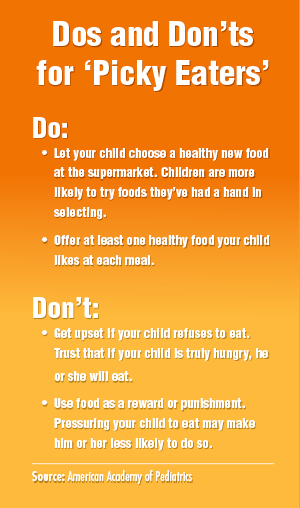To sidestep 'picky eaters,' make healthy foods fun
Does your child act like he or she is allergic to anything green at dinnertime? Does he or she want to live on chicken nuggets, refusing to try anything new or healthy?
Before your peaceful family dinner turns into a parent vs. child standoff, take in these tips served up by Children’s of Mississippi experts at the University of Mississippi Medical Center.

“Getting into a standoff is one of the worst things you can do,” said Dr. Susan Buttross, UMMC professor of child development, host of Southern Remedy: Relatively Speaking on Mississippi Public Broadcasting and principal investigator of the Mississippi Thrive! Child Health Development Project. “In that situation, the child is always going to win.”
Shanda Sandridge, a nurse practitioner in the Children’s of Mississippi Pediatric Weight and Wellness Clinic, agreed.
“As a parent, I know that children being picky can be a worry,” Sandridge said, “but worry and stress won’t make a child want to eat.”
A big serving of understanding is called for, Buttross said.
“Some people have more sensitive senses of taste and smell than others,” she said. “What might be slightly bitter to some might be very bitter to others. Everyone’s taste buds are different.”

The keys, Sandridge said, “are to make eating healthy foods fun and to give the child a sense of choice.
“Get creative. You can cut fruit into interesting shapes, give healthy foods fun names or put baby carrots and other fresh veggies into a plastic bag and clip with a clothespin to make a butterfly.”
It’s not unusual for children to want to eat their favorite foods to the exclusion of other options, but this is a phase that will pass, Sandridge said.
“Taste buds do change as children grow up. Things they don’t like now might be favorites in a few years.”
There are picky eaters, and then there are problematic eaters.

“When family mealtime is something that’s dreaded by everyone, it may be time to see a specialist,” said Rachel Tyrone, a speech-language pathologist with UMMC and Mississippi Thrive!
Among children whose eating habits may be problematic are those with developmental delays and who may be on the autism spectrum, as well as those who may have issues with swallowing. Tyrone said interventions can help change mealtime from “something to dread” to being a time when families can connect.
“One way to help is to involve the child in the meal process from beginning to end,” she said. “Let your child go to the produce aisle with you and help pick vegetables and fruits. Let them help in the kitchen. Depending on age, they can cut green onions with a blunt pair of scissors or help by mixing ingredients in a bowl.
“These activities will give your children sensory information, getting them interested in trying the foods they’ve helped select and prepare and encouraging them to do more.”
Another tip is to keep the portions of new foods small, Tyrone said.
“Give your child a few steamed green beans instead of a pile of them.”
Buttross said smaller servings are less intimidating for young children.
 “Start with three peas and maybe they don’t even have to taste them – just let them be on the plate. Then the next time, they touch them or smell them. Finally, the third try, they can taste them.
“Start with three peas and maybe they don’t even have to taste them – just let them be on the plate. Then the next time, they touch them or smell them. Finally, the third try, they can taste them.
“Easing into trying new foods makes it easier.”
When it comes to serving healthy foods, consistency is key, Tyrone said.
“Offer those green beans on a regular basis. Just because they didn’t eat them once doesn’t mean they won’t ever eat them. Every time you offer a healthy food is an opportunity for your child to try it.”
Children may be leery of new foods, but they’re introduced much more easily when they’re served with familiar favorites, Sandridge said. Raw broccoli florets might get a warmer welcome if they are served with a favorite, such as hummus or ranch dressing, if those dips are a hit with your child.
One of the best ways to get children to try and enjoy healthy foods is for parents to enjoy those foods themselves, Sandridge said.
“Children model what they see,” she said, “so if they see Mom and Dad enjoying a piece of fresh fruit or a salad, they’ll want to try it, too.”
The above article appears in CONSULT, UMMC’s monthly e-newsletter sharing news about cutting-edge clinical and health science education advances and innovative biomedical research at the Medical Center and giving you tips and suggestions on how you and the people you love can live a healthier life. Click here and enter your email address to receive CONSULT free of charge. You may cancel at any time.



